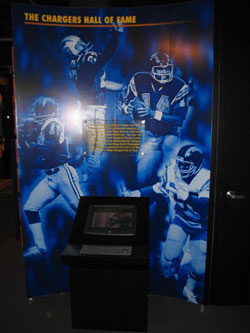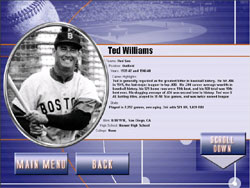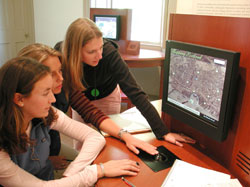Article
Museum kiosks bring new dimension to exhibits
Museum curators are finding that interactive displays bring a new element of learning to their patrons, and help relieve the stodgy, mothball-laden image that such establishments can have.
July 27, 2003
"People think that being in a museum means having to stand and read everything or just look at artifacts. But kiosks let them interact with information," said Steve Sloan, curatorial supervisor at the San Diego Hall of Champions, a museum that honors the city's famous coaches and athletes.
Museum curators are finding that interactive displays bring a new element of learning to their patrons, and help relieve the stodgy, mothball-laden image that such establishments can have.
"People don't even realize that they are learning, because they are having fun," said Charles Gaushell, principal of Paradigm Productions LLC, which has designed kiosk projects for museums such as The Children's Museum of Memphis in Tennessee.
"I think museum curators are hesitant to have computer-based exhibits because they think they are not tactile enough, and that people might get lost in too much detail," he said. "That can be true with an off-the-shelf solution."
 |
San Diego Chargers kiosk |
San Diego Hall of Champions
Sloan said kiosks bring a new dimension to the museum experience. "It gives patrons control over their visits," he said. Sloan said that in an age of computers and the Internet, it's only natural that kiosks be part of the landscape.
Sloan has been overseeing a project that incorporates eight kiosks from HTS Interactive into the museum. The project to date has cost about $200,000, including application development, project management, server programming and design. The build-out is about half done, said Kelly Mundell, HTS general manager. He estimates that there is another "few hundred thousand dollars worth" of work to be done.
The key to continuing the relationship, he said, is staying in constant contact with the customer, staying creative and doing some handholding.
|
Jim House, production manager at HTS, said one challenge his company had to overcome was getting non-technical people at the museum to understand how the kiosks could give the public usable information.
Sloan said the solution was to test the kiosks with visitors. Kids, in particular, run up to the kiosks. "It has been a great thing for families. You see kids walking their parents or grandparents through the systems. They sit there together for a while," said Sloan. Older visitors can get assistance from museum employees.
HTS designed a range of interactive apps that entice the public into San Diego's newly remodeled sports museum. The organization wanted to offer a vast artifact inventory of sports memorabilia and statistical information accumulated over the years. Kiosks solved the problems of limited space and staff.
"If we had to spread out this information, it would take a whole level of the museum. We would have to pick and choose what to display, and people might be left out," said Sloan.
The Hall of Champions wanted to have kiosks built into exhibits that give information on the San Diego Chargers, prominent football and baseball players from San Diego, and all of the athletes who had received awards in San Diego.
The Chargers Hall of Fame kiosk has an interface that is true to the Chargers' logos and colors. The information about the players pulls from a database that contains historical information such as a player biography, full statistical information and a photo gallery.
"The biggest challenge for us was matching the physical look and feel of the surrounding environment," said Mundell. He said the solution was to work closely with the design team and to get sign-offs at every stage of the project "just in case."
HTS also designed a Football Prominence kiosk that showcases San Diego prep and college athletes who have played in at least one professional football game. HTS designed an application and database to hold constantly changing information.
 |
Screen on baseball kiosk |
Another project is a kiosk for baseball players. The applications reflect San Diego's love of baseball and the San Diego Padres.
The latest phase of the project installed is the San Diego Awards kiosks. These kiosks honor people who have received awards in San Diego related to a sporting achievement. This includes coaches of the year, awards by sport, special recognition awards, and the Breitbard Hall of Fame, which is awarded to exceptional athletes for achievement over a lifetime.
These kiosks showcase people who might not receive notice because their sports are not mainstream or televised. The kiosks feature both video and still photos of the award recipients.
"When visitors see an uncle or grandmother, or even themselves featured, it really means something," said Sloan.
The Hall of Champions project uses a 15-inch touchscreen from EloTouch Systems, RAFI rugged keyboards and trackballs, and Dell Optiplex GX260 PCs.
HTS' TouchManager back-end management software links the kiosks. HTS developed this for remote monitoring, remote updating and usage reporting.
The staff at the Hall of Champions can keep their kiosks up to date without needing outside assistance. From their desktop they can check status of the units, determine if any are having hardware problems, check how the kiosks are doing and push out any updates to the system.
 |
Kiosk at The Children's Museum of Memphis |
The Children's Museum of Memphis
Since 1997, the museum has offered kiosks for kids to interact with in learning about careers, said Randy McKeel, public relations and marketing manager for the Children's Museum of Memphis. The target audience is children ages 1 to 12, and their grown-up chaperones.
"The challenge we face is that we have a variety of users, from young children up to adults. We have to engage users to get lessons across," said Cecilia Palazola, director of education for the museum. "The hardest thing is to keep things simple."
She offered as an example the air traffic controller kiosk. "We had to explain a complex occupation simply enough so that kids could make the decisions that a real air traffic controller would make."
Gaushell, whose company designed the kiosks, said this project cost about $20,000 total. He said the kiosk is not freestanding, but is mounted into a control tower. Paradigm buys kiosk components from various manufacturers and builds the custom project.
Kids are the not the only museum visitors to enjoy the kiosks, McKeel said. Parents, in particular, like the "Your House, My House" kiosk, which lets users build their own homes at a realistic construction site. Another kiosk in the exhibit allows users to decorate the house, choosing everything from paint colors to hardwood floors or carpeting.
This exhibit also has a traveling version that the museum will loan to other venues. This version lets kids build houses from around the world. Kids select an environment, like the jungle or a desert, and the kiosk program offers choices of construction materials for houses for these environments.
"Going Places" is a flight simulator kiosk that lets children "fly" over the Memphis skyline. Kids can also build their own airplanes. When the plane is complete, the kids hear applause, and the plane flies off.
"Waterworks" is a kiosk on which kids can learn about careers pertaining to water, such as engineering, meteorology or being a riverboat captain on the Mississippi River.
The "Growing Healthy" exhibit has two kiosks, one that lets kids learn about careers in healthcare, another that lets kids make choices about healthy eating.
At the "Animation Station" kiosk, kids can put together their own cartoons.
The museum works closely with Paradigm to put the systems together. The Children's Museum of Memphis is now partnering with the firm to market the exhibits to other museums.
 |
Kiosk at the Portland Museum of Art |
The Portland Museum of Art
"We had plenty of naysayers who thought it wasn't appropriate to use technology in a historical house; that it couldn't be elegant enough," said Dana Baldwin, director of education at the Portland Museum of Art in Maine, about kiosks in McLellan House, an 1801 Federal-style mansion on museum grounds.
"But it works. And the benefits we have seen are incredible." The house now has five kiosks.
Baldwin said the museum had several goals for the house: to show how a house like the McLellans' was built, to show what Portland was like during the 1800s and to demonstrate how the art community has evolved over that time.
"We wanted to offer visitors a different way to understand the house, and we realized that some type of interactive strategy was needed to tell all the different stories," said Baldwin.
One kiosk lets visitors select from 10 three-minute videos documenting pivotal events of a two-year restoration process. The other kiosks allow more interaction.
The first kiosk visitors encounter is called "Build It." Users begin with a blank 19th Century parlor, and zero 1801 dollars. They select items to decorate the room, and then are able to compare their finished interior with the actual McLellan room.
"This kiosk is the icebreaker. People love shopping and seeing the dollars add up," said Baldwin. She said the museum does not have staff helping visitors with the kiosks since the machines are intuitive and offer detailed instructions.
Another kiosk, "Behind These Walls," offers users the chance to virtually roam through rooms and click on hot spots to find out nuggets of information about life in the house, and culture in Portland.
There are two kiosks in the family room of McLellan House. One, "Look Inside," lets users see how people of the McLellan's era used certain household objects. The other, "Mapping Portland," offers three maps of the city (from 1800, 1837 and 1877) and shows where various artists had their studios. By clicking on the studios, users can find out about the artist's work, and how he or she interacted with other Portland artists.
"The kiosks let us show what visitors would never normally see, like a signature inside a drawer or on the back of a painting," said Baldwin. "We can show the works of art in a new context."
Baldwin said the kiosk project, open since October 2002, has brought new esteem to the Portland Museum of Art. "Our visitors see us in a league of innovation that we didn't enjoy before," said Baldwin. But even more importantly, she said, is that the staff thinks differently about how it presents art.
This fall, the museum will have an exhibit on the work of 1800-era Portland artist Charles Frederick Kimball. "We have photos of him hanging out with his contemporaries, having lunch, working...so much that people would never get to see. Now we know we could put together a slide show and put it on a flat screen. We never would have thought of that before," said Baldwin.
She said her staff is thinking about another kiosk for McLellan House. "The second bedroom needs an exhibit and we are thinking of featuring the last resident of the house. There is way too much material on this lady to have a static display do her justice."
[Editor's note: Info Touch Technologies became Tio Networks in April 2006.]









